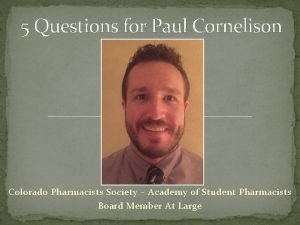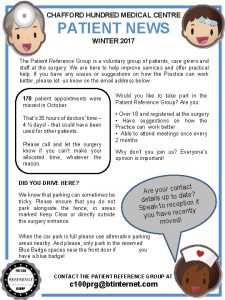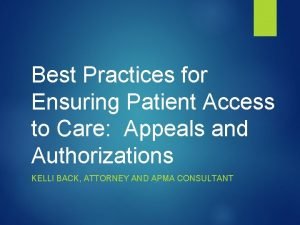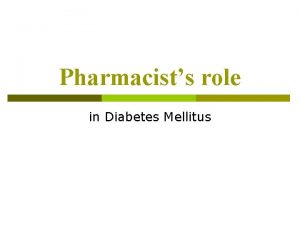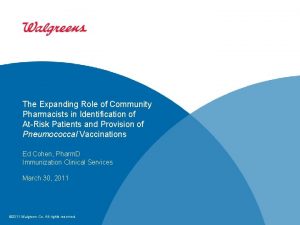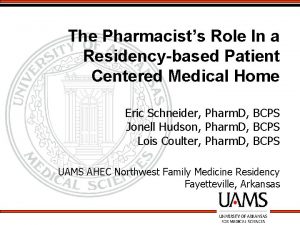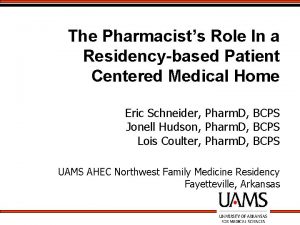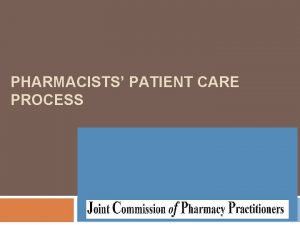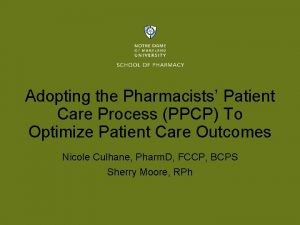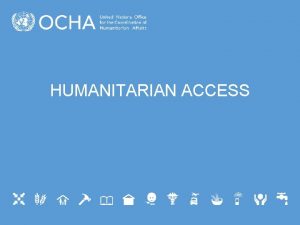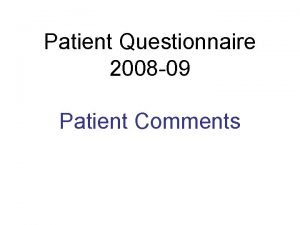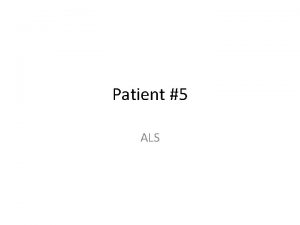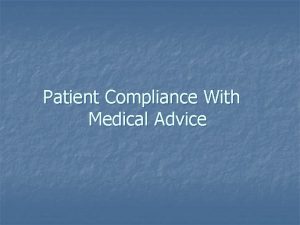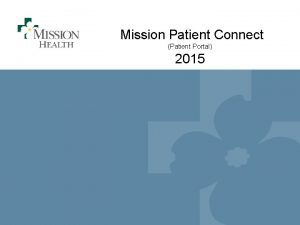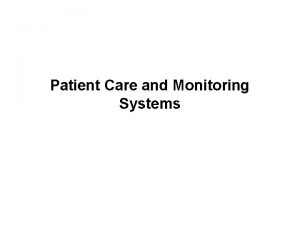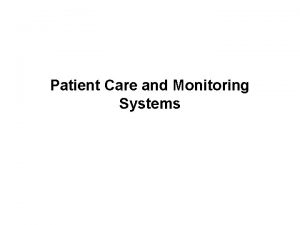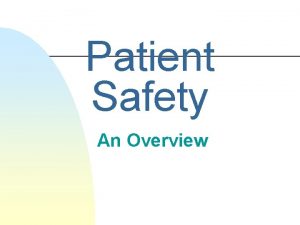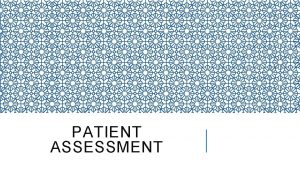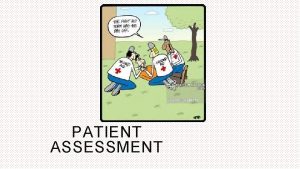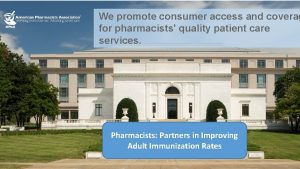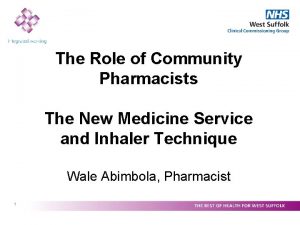Expanding the Role of Pharmacists Expanding Patient Access




















































- Slides: 52

Expanding the Role of Pharmacists = Expanding Patient Access to Care Legislative and Regulatory Update MPA Sesquicentennial Meeting Oct. 14, 2017 Nancy A. Alvarez, Pharm. D, BCPS, FAPh. A President - 2017 -2018 American Pharmacists Association

Disclosures Nancy A. Alvarez declares no conflicts of interest, real or apparent, and no financial interests in any company, product, or service mentioned in this program, including grants, employment, gifts, stock holdings, and honoraria 2

Learning Objectives At the completion of this activity, participants will be able to: • Outline the details of federal provider status legislation and recent activity. • Explain state-level opportunities that may increase patient access to pharmacists’ services. • Describe how success at the federal and state level can impact pharmacists and their practice. • Discuss ways to advocate and get involved. 3

Assessment Question #1 At the federal level, the profession is advocating for legislative changes to which government program in effort to provide coverage for pharmacists’ services? a) Medicaid b) Medicare Part A c) Medicare Part B d) Affordable Care Act and the federal and state health exchanges 4

Assessment Question #2 Provider status success at the federal, state and/ or private sector levels will: a) Better integrate the pharmacist into the patient’s health care team and help improve patient outcomes b) Increase opportunities for pharmacists to contribute to more efficient and coordinated delivery of care c) Increase patient access to health care and pharmacists’ opportunities to provide more patient care services d) All of the above 5

Assessment Question #3 Which of the following advocacy ideas would not be beneficial to the provider status effort? a) Pharmacists should reach out to members of Congress and their staff and invite them to their pharmacy practice. b) Develop an email campaign focused on disparaging other healthcare providers (e. g. physicians and nurses) and highlighting patients’ trust in the pharmacist. c) Write a letter to the editor or provide articles to local newspapers on pharmacists’ patient care services/ the value the pharmacists provide patients. d) Contribute to a political action committee (PAC) supporting federal provider status legislation. 6

What APh. A Does We promote consumer access and coverage of pharmacists’ quality patient care services. 7

Pharmacists’ Services Examples of pharmacists’ services that, in coordination with other health care team members, can help patients and their access to care: • Chronic disease management and education: Helping patients improve the management of their condition(s) and optimize the benefits of their medications and health outcomes. Goal setting, monitoring, medication management services and coaching help improve conditions such as diabetes, cardiovascular disease, and respiratory disease • Medication Management: Conducting a comprehensive review of a patient’s medications for appropriateness, effectiveness, safety, and adherence, and providing ongoing monitoring, as needed. Goal is to optimize medication use and health outcomes. 8

Pharmacists’ Services Examples of Pharmacists’ Services (cont’d): • Health and wellness: Providing patients with annual and lifetime immunizations; blood pressure checks; cholesterol and glucose testing; weight management; tobacco cessation counseling; and other preventive services • Care transition: Managing medications and coordinating information with other health care professionals to assist patients in transitioning smoothly between health care settings and prevent negative events like hospital readmissions 9

Pathways to Provider Recognition • Federal Sector – Social Security, Medicare Part B & D, CMMI, ACO – Federal regulations (CMS, AHRQ, HRSA) • State – Medicaid – Health insurance exchanges, state health plans – Existing provider status & collaborative practice • Private Payer – ACOs – Private or employer-based insurers – Medical homes 10

Ways to Optimize Pharmacists’ Value in States* Provider Designation Payment for Service Practice Act Optimization *Information provided by National Alliance of State Pharmacy Associations 11

State Level Changes Insurance Code Other Areas of State Laws • • There is sometimes a list of professionals who are defined as health care providers for the purposes of the provisions in the insurance code Challenge: A limited number of patients are covered by insurers who are held to these provisions (non-ERISA exempt plans) Pharmacy Practice Act Business/Professional Code – Being “on the list” as a provider here may not have much of an impact on payment for services unless areas of the insurance code, Medicaid provisions, or state employee benefit provisions refer back to this language • Pharmacists can also be separately recognized as providers within Medicaid laws 12

Other Requirements Affecting Coverage • Credentialing: The process by which an organization or institution obtains, verifies, and assesses an individual’s qualifications to provide patient care services • Privileging: Permission or authorization granted by a hospital or other health care institution or facility to a health professional (e. g. , physician, pharmacist, nurse practitioner) to render specific diagnostic, procedural, or therapeutic services • Additional Training/ Certifications – E. g. , for immunization administration, states require completion of a qualified training program 13

Scope of Practice Collaborative Practice Agreements Statewide Protocols 14

Scope Components/ Opportunities • Practice of Pharmacy • Collaborative Practice Provisions • Immunization Authority • Order/ interpret labs, CLIA waived tests • Statewide protocols to enhance public health *Information provided by National Alliance of State Pharmacy Associations 15

Statewide Protocols vs CPAs Statewide Protocols • • • Standardized for any willing and qualified pharmacist in the state Pharmacist/pharmacy doesn’t need to find someone to sign off Not patient-, pharmacist-, or providerspecific Very focused service Protocol-driven authority Parameters are not modifiable by individual pharmacists • • • CPAs Negotiated between prescribers & pharmacists Requires pharmacist to identify a collaborating prescriber Could be patient-, disease state-, or patient population-specific Services may be broad & address a variety of conditions Care may or may not be protocol driven Parameters are modifiable and negotiable between the participating providers 16

CPA Applications • • • Chronic Disease Management – Anticoagulation – Cardiovascular disease/hypertension – Diabetes – Others Acute Treatment – E. g. point of care testing, such as rapid strep test Public Health – E. g. Naloxone 17

Statewide Protocols • Naloxone • Immunizations • Smoking Cessation • Hormonal Contraceptives • Travel Medications 18

Payment for Pharmacists’ Services 19

Payment for Services* 31 • Some kind of Payment 17 • Some Medicaid Service 12 • Medicaid MTM 6 • State Employee MTM *Information provided by National Alliance of State Pharmacy Associations 20

Pharmacy’s Federal Provider Status Efforts 21

Patient Access to Pharmacists’ Care Coalition www. Pharmacists. Care. org 22

Patient Access to Pharmacists’ Care Coalition • Broad coalition of pharmacy organizations and stakeholders focused on regulatory and legislative action • Coalition seeking provider status for pharmacists including advocacy for: ‒ Consumer/patient access & coverage for pharmacists’ patient care services ‒ Payers & policy makers to recognize pharmacists as health care providers who improve access, quality, & value of health care ‒ Enhanced inclusion of pharmacists as members of patient health care teams • APh. A serves on the PAPCC’s Steering Committee & has committed several million dollars to supporting the PAPCC, including a media campaign targeted to lawmakers. 23

Patient Access to Pharmacists’ Care Coalition Nearly 40 organizations and growing! 24

Federal Legislation H. R. 592 / S. 109 Pharmacy and Medically Underserved Areas Enhancement Act • Representatives Brett Guthrie (R-KY), G. K. Butterfield (D-NC), Tom Reed (R-NY), and Ron Kind (D-WI) introduced H. R. 592 on January 20, 2017 126 Original Co-sponsors • Senators Chuck Grassley (R-IA), Sherrod Brown (D-OH), Susan Collins (R-ME) and Robert Casey (D-PA) introduced S. 109 on January 12, 2017 27 Original Co-sponsors • Amends section 1861 of the Social Security Act to recognize pharmacists’ services within Medicare Part B The entire Maine delegation is signed on to the bills! • No. of Cosponsors H. R. 592 – 214 S. 109 – 45 Bipartisan as of October 9, 2017 25

Patient Access to Pharmacists’ Care Coalition H. R. 592 / S. 109 – Scope of Proposal • Pharmacists – State-licensed pharmacists with a B. S. Pharm. or Pharm. D. degree who may have additional training and certificates depending on state laws • Services – Services authorized under state pharmacy scope of practice laws • Patients – Services provided in/ for Medically Underserved Areas (MUA), Medically Underserved Populations (MUP), or Health Professional Shortage Areas (HPSA) No impact on state scope of practice 26

Patient Access to Pharmacists’ Care Coalition Are only a limited number of pharmacists eligible under H. R. 592 / S. 109? 27

Patient Access to Pharmacists’ Care Coalition Are only a limited number of pharmacists eligible under H. R. 592 / S. 109? 28

Provider Status Effect on Pharmacy Practice 29

Potential Operational Changes • Changes in workflow – Increase in pharmacist’s face-to-face time with patients – Shift to appointment-based care • Changes in facilities – Need for more private consultative areas – Need for access to electronic health records – Increase central-fill – Provision of care off site 30

Potential Operational Changes • Changes in billing mechanisms – Medical insurance – Partnerships for bundle payments – Outcomes based vs fee for service • Changes in role of the pharmacist – – – • Building patient relationships/ engage patient in their care Increased collaborations/ team-based care Effective documentation for care delivered Additional training or verification of performance ability Performance appraisal system - meeting outcomes vs # of Rxs Liability 31

Profession’s Next Steps 32

PAPCC Strategy Considerations • Timeline – Dependent on possible vehicle/ other health care reform legislation • Cost of the legislation/ Congressional Budget Office (CBO) Score 33

PAPCC Next Steps • Work with lead sponsors and committee leadership on next steps and timeline • Continue to build co-sponsor support/ utilize full coalition grassroots • Continue discussions with administration • Monitor activity in states 34

Pharmacy’s Next Steps • Federal efforts is only one of our profession’s pathway to success – Pharmacy-related associations and pharmacists’ progress in helping patients receive better coordinated care has been impressive at the state level o States demonstrating impact pharmacists can have on patients and health care, including helping to fulfill needs of patients o These efforts are valuable to our federal level efforts as well • APh. A will continue to work with others to make the case for increasing access to pharmacists’ patient care services 35

Pharmacy’s Next Steps • Incorporate solutions to and offerings for policymakers & decision-makers’ concerns and what they value ‒ • Take advantage of state laws and actions – • E. g. transitions of care, movement towards coordinated care and new delivery models, address high cost items E. g. individual Medicaid programs and health exchanges Continue to demonstrate value – quality, favorable patient outcomes, cost • Highlight evidence and continue research ‒ ‒ As robust as possible but don’t let the perfect be an enemy Data is important but may not need to be in peer-reviewed literature 36

Making the Case for Pharmacists’ Services 37

Health Care Environment Problems and Opportunities • Total health care spending in the United States was $3. 4 trillion in 2016 and $75 billion in 1970. 1 Health care spending is projected to grow 5. 6 percent per year, on average, and will account for nearly 20 percent of GDP by 2025. 1 • The US spends almost $300 billion annually on medication problems including medication non-adherence. 2 • Chronic diseases costs the US health care system $1. 7 trillion annually (more than 75% of health care spending). 3 1. Centers for Medicare and Medicaid Services, National Health Expenditures Projections 2016 -2025. https: //www. cms. gov/Research-Statistics-Data-and-Systems/Statistics-Trendsand-Reports/National. Health. Expend. Data/National. Health. Accounts. Projected. html 2. New England Healthcare Institute. Thinking Outside the Pillbox: A System-wide Approach to Improving Patient Medication Adherence for Chronic Disease. August 2009. http: //www. nehi. net/publications/17 -thinking-outside-the-pillbox-a-system-wide-approach-to-improving-patient-medication-adherence-for-chronic-disease/view 3. Partnership to Fight Chronic Disease. 2009 Almanac of Chronic Disease. Available at: http: //www. fightchronicdisease. org/resources/almanac-chronic-disease-0. 38

Health Care Environment Percentage of Medicare Fee for Service Beneficiaries by Number of Chronic Conditions Medicare enrollment is expected to grow from roughly 55 million in 2017 to 75 million by 2027. Centers for Medicare and Medicaid Services. Chronic Conditions among Medicare Beneficiaries, Chartbook, 2012 Edition. Baltimore, MD. 2012. https: //www. cbo. gov/sites/default/files/recurringdata/51302 -2017 -06 -medicare. pdf 39

Health Care Environment Problems and Opportunities • Nearly 70 percent of Americans are on at least one prescription drug, and more than 50 percent take two. 1 • In 2016, there were more than 4 billion prescriptions filled at US outpatient pharmacies – an average of more than 12 prescriptions/person. 2 • Almost 50% of people prescribed medications for chronic diseases do not take their medications correctly. 3 Pharmacists with their education and training (including more medication education than other providers) can help improve these statistics 1. 2. 3. Nearly 7 in 10 Americans Take Prescription Drugs, Mayo Clinic, Olmsted Medical Center Find, http: //newsnetwork. mayoclinic. org/discussion/nearly-7 -in-10 americans-take-prescription-drugs-mayo-clinic-olmsted-medical-center-find Kaiser Family Foundation. http: //kff. org/other/state-indicator/retail-rx-drugs-per-capita/ Sabaté E, editor. , ed. Adherence to Long-Term Therapies: Evidence for Action. Geneva, Switzerland: World Health Organization; 2003. 40

Health Care Access is a National Problem 41

Growing Support for Pharmacists’ Value 42

Research / Evidence Pharmacy Organization Value of Pharmacy Project • Independent report released on May 2014; available at http: //avalerehealth. net/ • Report explores pharmacists services currently being provided and their contribution to health/ health care system • Identified the most recent U. S. research articles and focused on four pharmacist services and one care delivery arrangement: – Medication management; medication reconciliation; preventive services; counseling; and collaborative care models 43

Evidence Supporting Value Patients Benefit from Medication. Related Services; examples include: 44

Support for Pharmacy Issued January 2015 45

Support for Pharmacy On January 17, 2017 CMS’s Center for Medicaid and CHIP Services (CMCS) Issued an “Information Bulletin” to states • Encourages state flexibility to facilitate timely access to drug therapy by expanding the scope of pharmacy practice – “CMCS encourages states to consider using these methods to promote access particularly to those drugs that can help address priority public health issues” – “These practices can facilitate easier access to medically necessary and time-sensitive drugs for Medicaid beneficiaries” 46

APh. A Advocacy Resources APh. A: Pharmacists. Provide. Care. com • Join the Campaign! – State-specific information • Fact Sheets – Making the case – Infographics – Public opinion polls – Scope of practice • Student Tool Kit • Supporter Engagement – Monthly Newsletters – Letters to Members of Congress – Advocacy Alerts • Messaging – – E. g. , FAQ – Social Media efforts - videos Pharmacists’ Involvement Needed! 47

APh. A Provider Status Activities www. pharmacistsprovidecare. com • • Messaging, stories and profiles highlighting pharmacists’ services SHARE YOUR STORY! Show you care about your patients. Identifying other health care providers supportive of pharmacists You don’t have to go to Washington DC to make a difference!! 48

Assessment Question #1 At the federal level, the profession is advocating for legislative changes to which government program in effort to provide coverage for pharmacists’ services? a) Medicaid b) Medicare Part A c) Medicare Part B d) Affordable Care Act and the federal and state health exchanges 49

Assessment Question #2 Provider status success at the federal, state and/ or private sector levels will: a) Better integrate the pharmacist into the patient’s health care team and help improve patient outcomes b) Increase opportunities for pharmacists to contribute to more efficient and coordinated delivery of care c) Increase patient access to health care and pharmacists’ opportunities to provide more patient care services d) All of the above 50

Assessment Question #3 Which of the following advocacy ideas would not be beneficial to the provider status effort? a) Pharmacists should reach out to members of Congress and their staff and invite them to their pharmacy practice. b) Develop an email campaign focused on disparaging other healthcare providers (e. g. physicians and nurses) and highlighting patients’ trust in the pharmacist. c) Write a letter to the editor or provide articles to local newspapers on pharmacists’ patient care services/ the value the pharmacists provide patients. d) Contribute to a political action committee (PAC) supporting federal provider status legislation. 51

Discussion & Questions For more information on APh. A’s provider status activities Visit www. pharmacistsprovidecare. com 52
 Colorado pharmacists society
Colorado pharmacists society Patient 2 patient
Patient 2 patient Admission of an ambulant patient
Admission of an ambulant patient Role of nurse in patient teaching ppt
Role of nurse in patient teaching ppt Heaton moor doctors
Heaton moor doctors Heaton moor medical centre patient online access
Heaton moor medical centre patient online access Patient access best practices
Patient access best practices Role conflict occurs when fulfilling the role expectations
Role conflict occurs when fulfilling the role expectations Web role in azure
Web role in azure Symbolischer interaktionismus krappmann
Symbolischer interaktionismus krappmann Access control matrix adalah
Access control matrix adalah Terminal access controller access-control system
Terminal access controller access-control system Terminal access controller access control system
Terminal access controller access control system Biện pháp chống mỏi cơ
Biện pháp chống mỏi cơ Trời xanh đây là của chúng ta thể thơ
Trời xanh đây là của chúng ta thể thơ Chó sói
Chó sói Thiếu nhi thế giới liên hoan
Thiếu nhi thế giới liên hoan Tia chieu sa te
Tia chieu sa te Các châu lục và đại dương trên thế giới
Các châu lục và đại dương trên thế giới Một số thể thơ truyền thống
Một số thể thơ truyền thống Thế nào là hệ số cao nhất
Thế nào là hệ số cao nhất Hệ hô hấp
Hệ hô hấp Tư thế ngồi viết
Tư thế ngồi viết Thế nào là số nguyên tố
Thế nào là số nguyên tố Hình ảnh bộ gõ cơ thể búng tay
Hình ảnh bộ gõ cơ thể búng tay đặc điểm cơ thể của người tối cổ
đặc điểm cơ thể của người tối cổ Mật thư anh em như thể tay chân
Mật thư anh em như thể tay chân Tư thế worm breton
Tư thế worm breton ưu thế lai là gì
ưu thế lai là gì Thẻ vin
Thẻ vin Cái miệng bé xinh thế chỉ nói điều hay thôi
Cái miệng bé xinh thế chỉ nói điều hay thôi Thể thơ truyền thống
Thể thơ truyền thống Các châu lục và đại dương trên thế giới
Các châu lục và đại dương trên thế giới Bổ thể
Bổ thể Từ ngữ thể hiện lòng nhân hậu
Từ ngữ thể hiện lòng nhân hậu Diễn thế sinh thái là
Diễn thế sinh thái là Tư thế ngồi viết
Tư thế ngồi viết Slidetodoc
Slidetodoc Ví dụ về giọng cùng tên
Ví dụ về giọng cùng tên 101012 bằng
101012 bằng Alleluia hat len nguoi oi
Alleluia hat len nguoi oi Hổ sinh sản vào mùa nào
Hổ sinh sản vào mùa nào đại từ thay thế
đại từ thay thế Vẽ hình chiếu vuông góc của vật thể sau
Vẽ hình chiếu vuông góc của vật thể sau Công thức tính thế năng
Công thức tính thế năng Thế nào là mạng điện lắp đặt kiểu nổi
Thế nào là mạng điện lắp đặt kiểu nổi Tỉ lệ cơ thể trẻ em
Tỉ lệ cơ thể trẻ em Lời thề hippocrates
Lời thề hippocrates Dot
Dot Vẽ hình chiếu đứng bằng cạnh của vật thể
Vẽ hình chiếu đứng bằng cạnh của vật thể độ dài liên kết
độ dài liên kết Quá trình desamine hóa có thể tạo ra
Quá trình desamine hóa có thể tạo ra Các môn thể thao bắt đầu bằng tiếng nhảy
Các môn thể thao bắt đầu bằng tiếng nhảy
